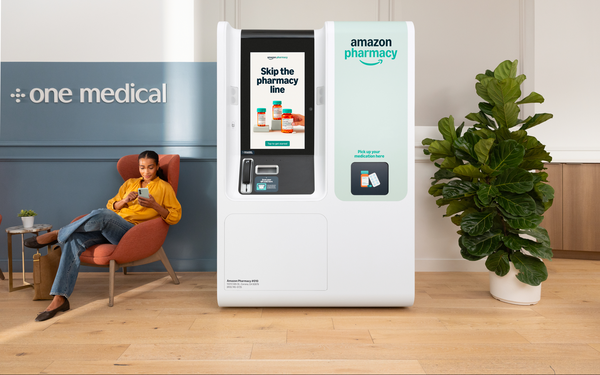
How can Amazon Pharmacy
top same-day delivery of prescription medications?
Would you believe vending machines right in doctors’ offices?
The service just announced the December debut of Amazon Pharmacy
Kiosks in at least five One Medical primary care locations in Los Angeles, with “other locations to follow.”
Los Angeles had been one of two launch cities, along with New York, for
the launch of same-day Amazon Pharmacy delivery in March 2024. Now available in 20 cities, same-day delivery helped Amazon Pharmacy grow 50% year-over-year in Q2 2005, per an earnings call. (Amazon
doesn’t reveal specific revenues for the pharmacy service.)
The new kiosks represent perhaps the most direct synergy yet within Amazon’s health business, which had earlier included
such changes as Amazon Clinic becoming Amazon One Medical Pay-Per-Visit.
advertisement
advertisement
Amazon Pharmacy launched five years ago following the ecommerce giant’s $1 billion acquisition of PillPack, and
One Medical was acquired in a $3.9 billion deal in 2023.
An Amazon
Pharmacy video shows a One Medical doctor walking a patient to a
kiosk, the patient then signing into Amazon Pharmacy on her app, setting that kiosk as her pickup location, and then using a QR code to get her prescription from the machine.
But, wait! The
kiosk screen tells her that “You have a medication that requires consultation, calling pharmacist now.” She then has a voice conversation with a pharmacist (handsets are available for
privacy), signs an on-screen “pickup agreement,” and the kiosk dispenses her medication. The video -- and entire process -- lasts less than two minutes.
“We know that when
patients have to make a separate stop after seeing their doctor, many prescriptions never get filled,” Hannah McClellan, Amazon Pharmacy’s vice president of operations, said in a
statement. “By bringing the pharmacy directly to the point of care, we’re removing a critical barrier and helping patients start their treatment when it matters most—right
away.”
How will Amazon get an entire pharmacy’s stockroom into a kiosk?
The easy answer is that it won’t. “Powered by Amazon’s logistics expertise
and technology,” the company said, “each kiosk is stocked with a curated inventory of medications based on the prescribing patterns of the specific One Medical office where they’re
located.”
Reuters reported that the kiosks
will contain “common medications,” with those in Los Angeles including antibiotics, asthma inhalers and treatments for high blood pressure.
McClellan told Reuters that Amazon
Pharmacy plans to extend the kiosks outside of California next year, that talks are underway with “external health systems” to also launch the machines, and that neither refrigerated meds
like GLP-1 nor “tightly regulated prescriptions like controlled pain medications” will be on the menu.
Seeking Alpha noted that the kiosks represent “another layer” in
Amazon’s attempt to squeeze out competitors like CVS, Walgreens and Walmart “across the retail/healthcare industry.”
Those competitors had long beaten Amazon to the punch in
uniting on-site healthcare providers writing prescriptions with quick pickups at nearby pharmacy counters, but the formula has been far from an overwhelming success.
While CVS still offers CVS
Clinics, Walgreens sold off its VillageMD business last month, and Walmart shut down its own in-store health clinics last year.
And even with CVS and Walgreens in the process of closing
hundreds of stores -- coupled with the loss of all Rite Aid outlets -- Amazon Pharmacy has a long road ahead in approaching those retailers’ brick-and-mortar reach, not to mention their medicine
inventory.
Dr. Patrick Ryan, a physician at San Diego Sports Medicine and founder of the Hemryx telehealth platform, added that while Amazon Pharmacy’s prescription kiosks “may be
convenient in some cases, it raises ethical and clinical concerns. Doctors may be pressured to prescribe medications that are stocked, narrowing treatment options for patients.”
“Doctors will prescribe meds that the machines carry if there are no open pharmacies nearby,” stated Christine Long, a former pharmacist who recently founded TelaVets for pet
telehealth, “but at least the patients get their medications same day.” “If there are pharmacies nearby,” she continued, “they’ll prescribe meds that are available
at the pharmacy, not just the kiosk.”
On the other hand, Forrester Principal Analyst Arielle Trzcinski told Fierce Healthcare that – assuming equal insurance acceptance
and pricing -- location is the most important factor to consumers in choosing a pharmacy, followed by speed of getting prescriptions filled. As a result, he said, “Co-location can address a
litany of challenges.”